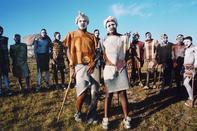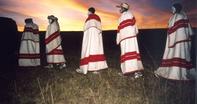Clan Names
The patronymic or clan name used by an adult male or female Xhosa is inherited from his or her father and membership of the agnatic cluster coincided with affiliation to a particular clan. However, the clan was a much wider grouping than the agnatic cluster, which mainly had local importance.

The various members of one clan very often lived in different areas and were followers of different clan leaders as well as chiefs. Clan leaders with large followings in a particular chiefdom represented their followers on the chief's council and participated in all decisions affecting the chiefdom.
Clan members were descendants of a putative common great-grandfather, although this could not be proved. Members of the same clan did not intermarry and a woman retained her clan name even after marriage. The clan name still has significance today as an index of social identity. When strangers meet, they very often introduce themselves by mentioning their respective clan names. In this way mutual social connections is identified and established.
Xhosa Chiefdom
The homesteads of the Xhosa in a particular area fell under the jurisdiction and authority of the local chief in whose territory they were situated. The Great Place of the chief constituted the social, administrative, judicial and military centre of the chiefdom. Although the executive authority of the chiefdom ultimately rested with the chief's council rather than with the chief himself, the chief was nevertheless the figurehead, the father and bearer of the patronymic of the chiefdom.
The chief convened hunting, harvesting, warfare and circumcision — all cooperative communal activities involving the use of sharp metal instruments such as spears and hoes. These implements were all closely associated with the bush or forest and the shades 'spirits', as well as related notions of ritual purity and abstention 'ukuzila' from meat, sour milk, liquor, tobacco and sexual intercourse. These communal activities, therefore, involved special sacrificial rites and/or doctor with medicines.
The diviners and herbalists were historically agents of the chief, who made rain in times of drought, doctored the warriors before a battle, doctored the cultivated fields to ensure a good harvest, smelt out witches and treated illness and misfortune in man and beast. The chief's followers were the source of the able-bodied men who served as warriors in the army, defending the chiefdom against rival neighbouring chiefs or foreign incursions.
Death dues and fines for murder or witchcraft were payable to the chief in cattle. All the leopard pelts and half the ivory obtained in the hunt accrued to the chief, who was the only person entitled to wear a leopard skin robe 'umnweba' and an ivory armband 'umxhaka'. By 1831 Grahamstown was exporting £50,000 of goods annually, of which £27,000 was made up of hides and £3,000 of ivory purchased from the Xhosa.
The Xhosa in return acquired not only regular trade goods - blankets, beads and metal, but also horses and guns. The followers of the chief contributed cattle towards the bride wealth 'lobola' of the chief's Great Wife. They attended the annual military review at the Great Place, when the army was doctored by the war-doctor 'itola'. The ceremony of the first fruits 'ulibo' was held at the same time, at which the crops were ritually tasted by the chief before they were harvested in the fields.
Political Alignments of Xhosa Chiefdom

Although Xhosa chiefs belonged to the royal amaTshawe house, this did not necessarily mean that they were politically aligned on all issues all of the time. Political alignments could change depending on the issue at stake.
For example, during the epidemic of bovine lung sickness and the Cattle-Killing episode which followed it in 1856—7, some Xhosa chiefs supported the Paramount Chief Sarhili's call, which was based on the millennial prophecies of Mhlakaza and Nongqawuse, to destroy all cattle and grain, but others refused to do so.
Followers who were disaffected by an unpopular chief could turn their allegiance to a more popular chief. Similarly, an aristocrat, with sufficient political and military support, could usurp the chieftainship from a half-brother or he could move off, colonize new territory and create a new chiefdom of his own.
According to Xhosa oral tradition, Tshawe usurped the chieftainship from his half-brother Cirha. As a result of this action, Tshawe, the minor house of Nkosiyamntu, has ever since been the ruling house among the Xhosa. Later, during the 18th century, Chief Phalo's Right-Hand Son Rharhabe crossed the Kei River with his followers after a military clash with his younger half-brother Gcaleka, who was heir to the chieftainship. Rharhabe established his new chiefdom in the Amabele Hills, and the Ciskeian Xhosa came to be known as amaRharhabe, a patronymic which still has relevance today.